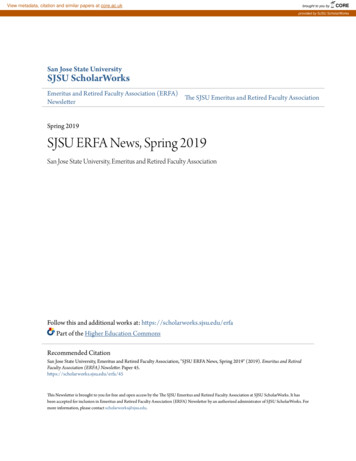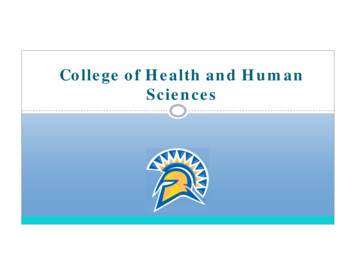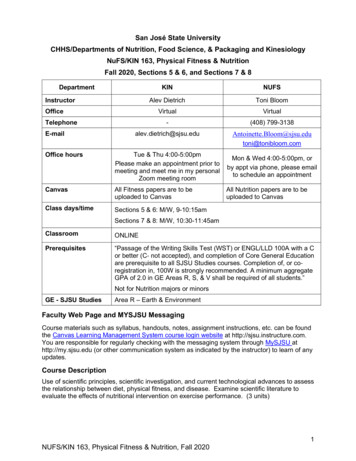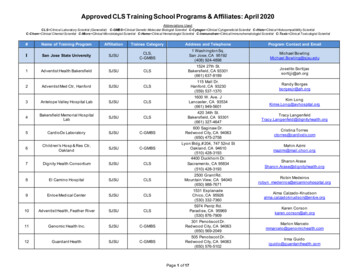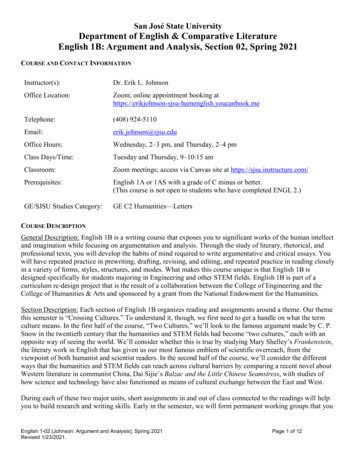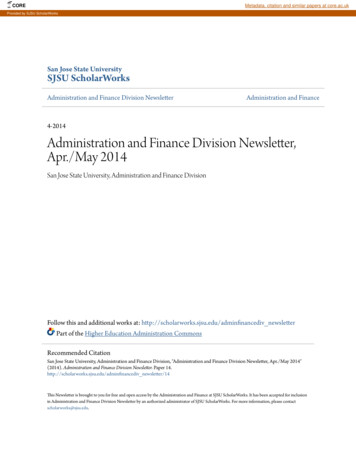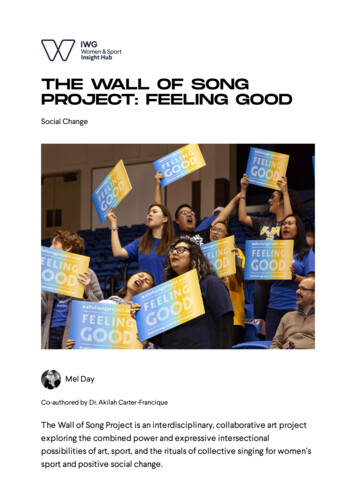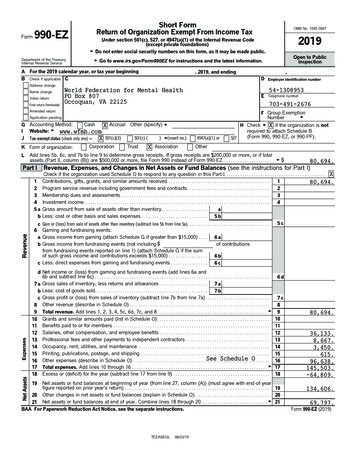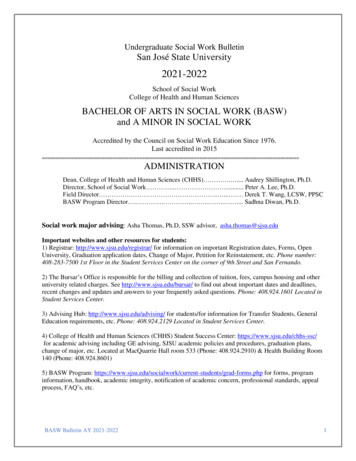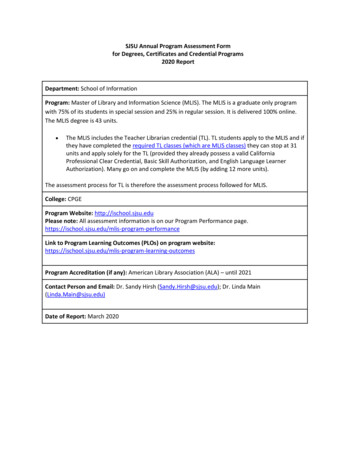
Transcription
SJSU Annual Program Assessment Formfor Degrees, Certificates and Credential Programs2020 ReportDepartment: School of InformationProgram: Master of Library and Information Science (MLIS). The MLIS is a graduate only programwith 75% of its students in special session and 25% in regular session. It is delivered 100% online.The MLIS degree is 43 units. The MLIS includes the Teacher Librarian credential (TL). TL students apply to the MLIS and ifthey have completed the required TL classes (which are MLIS classes) they can stop at 31units and apply solely for the TL (provided they already possess a valid CaliforniaProfessional Clear Credential, Basic Skill Authorization, and English Language LearnerAuthorization). Many go on and complete the MLIS (by adding 12 more units).The assessment process for TL is therefore the assessment process followed for MLIS.College: CPGEProgram Website: http://ischool.sjsu.eduPlease note: All assessment information is on our Program Performance anceLink to Program Learning Outcomes (PLOs) on program ning-outcomesProgram Accreditation (if any): American Library Association (ALA) – until 2021Contact Person and Email: Dr. Sandy Hirsh (Sandy.Hirsh@sjsu.edu); Dr. Linda Main(Linda.Main@sjsu.edu)Date of Report: March 2020
Part A1. List of Program Learning Outcomes (PLOs)Please -outcomesRubrics that describe how students can demonstrate ads/289 compRubrics.pdf2. Map of PLOs to University Learning Goals (ULGs)Please see: PLOs Mapped to ULGs3. Alignment – Matrix of PLOs to CoursesThe MLIS program has 16 units of required courses and 27 units of electives. All students must take thefollowing three (core) classes: INFO 200 (Information Communities), INFO 202 (Information RetrievalSystem Design), INFO 204 (Information Professions). All program learning outcomes are initiallyaddressed by the time a student completes these three required core classes. See syllabi for INFO 200,202, 204.Students then select their electives from a wide choice depending on which career pathway they arefollowing (they can also “mix and match” classes among career pathways). The electives reinforce theprogram learning outcomes (competencies) already addressed in the core classes. As instructors plan their classes and develop their syllabi, they determine which CoreCompetencies (Program Learning Outcomes) their classes address, and this information appearson each course syllabus. Multiple sections of a single course share the same Core Competencies(Program Learning Outcomes), agreed upon by the course instructors, with guidance from theassigned full-time faculty members who provide leadership for specific course clusters. Eachcourse cluster encompasses a group of related courses under the leadership of three to five fulltime faculty members with expertise in these areas. The course clusters and associated full-timefaculty leads, as well as a list of all courses in each cluster, are available online. In addition to defined Core Competencies (Program Learning Outcomes), each course hasspecific Course Learning Outcomes (CLOs). Each assignment is linked to the specific CourseLearning Outcome(s) it fulfills, and this information is indicated on each course syllabus. Allsections of a single course share common Course Learning Outcomes, although individualinstructors have the freedom to meet those objectives through their own assignments and classactivities. To help instructors establish CLOs for their courses, link CLOs to assignments, andindicate those links on their syllabi, we developed a tutorial that guides instructors through thisprocess. If an instructor is developing a new course or wants to change the CLOs or Core Competencies(Program Learning Outcomes) for a current course, the instructor submits the proposed CoreCompetencies and CLOs to the co-chairs of the School’s Curriculum and Program DevelopmentCommittee for review via a restricted online form. The Curriculum and Program Development2
Committee co-chairs examine the proposed assignments and Course Learning Outcomes to besure they fulfill the chosen competencies. These connections between Core Competencies (Program Learning Outcomes), Course LearningOutcomes, and course assignments are publicly available on our syllabi. In addition, studentscan easily view the Core Competencies (Program Learning Outcomes) and CLOs for each courseby using this database. To use the database, click on a specific course; then a topic if it is a coursewith multiple topics; the Core Competencies (PLOs) and CLOs for the course will be displayed. Students can also search for courses that address each Core Competency (Program LearningOutcome) using this online tool, which displays a list of courses that support each CoreCompetency (Program Learning Outcome). To use the tool, select any Core Competency(program learning outcome) and then view all courses that support the competency.For alignment of PLOs to courses please For alignment of courses to CLOs and PLOs (core competencies) please 4. Planning for AssessmentOverall Planning for AssessmentThe faculty conducts a systematic review of the whole curriculum on a three-year cycle. In the firstyear, we review the required courses of INFO 200, INFO 202, INFO 203, INFO 204, INFO 285. In thesecond year, we review the culminating experience and program learning outcomes and INFO289: e-Portfolio. In the third year, we review the Career Pathways. As part of this review, thefaculty members involved explore whether the current courses are appropriate, whether theprerequisites are fitting, and whether changes are needed in course descriptions. The facultymembers involved also explore whether new courses may be needed, based on their ownprofessional experience as well as feedback from our Program Advisory Committees (composed ofpractitioners).The table below provides an overview of our curriculum review cycle during our currentaccreditation period.Curriculum Review Calendar for Current Accreditation PeriodCurriculum ComponentTimelineCurrent Accreditation Period: Review #1Culminating ExperienceFall 2014–Spring 20153
Core courses, INFO 203, and INFO 285Fall 2015–Spring 2016Overall Program ReviewFall 2016Current Accreditation Period: Review #2Career PathwaysSpring 2017–Fall 2017Culminating ExperienceSpring 2018Core courses, INFO 203, and INFO 285Fall 2018–Spring 2019Overall Program ReviewFall 2019Career PathwaysSpring 2020-Summer2020Individual Program Learning Outcomes Assessment PlanningIn addition to the assessment of different areas of the curriculum each semester or academic year, wecollect data on individual program outcomes, discuss the results, and make changes.Please see:Review and Measurement of Individual Program Learning Outcomes; and the accompanyingreports. (Scroll down to: Assessment of Individual Program Learning Outcomes Reports MLIS. Thelatest is for Spring 2020).Direct links: program chments/soi mlis report sp2019 and f2019.pdf?15805026845. Student Experiencea.How are your PLOs and the ULGs communicated to students, e.g. websites, syllabi, promotionalmaterial, etc.?The PLOs are on our web site: comesb. Do students have an opportunity to provide feedback regarding your PLOs and/or the assessmentprocess? If so, please briefly elaborate.Our Core and Course Cluster Coordination model, our Program Advisory Committees, and ourformal curriculum review process constitute a significant component of the School’s approach tocurriculum planning and assessment. However, the School also evaluates the program based on4
the perspectives of students, employers, alumni, and other constituents, as well as students’achievements and subsequent accomplishments. The School uses various tools to assess studentsatisfaction and learning outcomes. We then use data from these assessment tools to inform ourcurriculum and program development decisions. These tools include: Student Opinion of Teaching Effectiveness (SOTE) surveysStudent Exit SurveysAlumni surveys (discussed in Part B: Assessment Data and Results) (Note: Alt (or Command)plus left arrow will return you to this page after checking out the link).Employer surveys (discussed in Part B: Assessment Data and Results)Internship Site Supervisors (discussed in Part B: Assessment Data and Results) SOTE SurveysAt the end of each semester, students are asked to complete a Student Opinion of TeachingEffectiveness (SOTE) online survey for each course in which they are enrolled. These surveys focuson the effectiveness of instruction in individual courses.SOTE results are sent directly to the SJSU Office of Institutional Research. Results are tabulatedand returned to the School for analysis and action. The Director reviews these results and usesthem as part of the Director’s annual review of part-time faculty.The Director has also prepared a summary presentation for faculty of common issues she seeswhen reviewing student SOTES.Our faculty review the anonymous SOTE surveys completed by students in their courses, and inresponse, they often modify their courses. Some examples of changes made by instructors inresponse to feedback from students in SOTES follow: I continually refine reading lists to ensure that they are as relevant as possible. I also notewhen older readings are included that offer historical perspectives, so that studentsunderstand their importance to course concepts. I give assignment details further inadvance so that all students are able to better manage their time. And I plan to implement asuggestion offered when I last taught to include an additional Zoom session on copyrightissues pertaining to media in libraries so that students have another opportunity to interactand ask questions about this complex issue. For my INFO 248 cataloging class, I have made video demonstrations with screen sharing ofall the major assignments, in response to requests or comments in SOTES about wantingmore information on how to complete assignments. Here are a few changes I made to my classes based on student feedback comments inSOTES:o Shortened lecture recordings.o Added small exercises to prepare students for major group projects.o Added weekly announcements as reminder of current tasks and upcoming dues.5
oCreated short videos to demo technical steps in technology-intensive courses. The most significant addition I made last year was adding an audio interview with the headof the Pikes Peak Library District (where I live) and his colleague from Eastern Europe onhow they navigate intercultural challenges in their system. They are especially involved withhomeless. Students have appreciated expanding their sense of cultures to include even thehomeless, not just recent immigrants and it has helped bridge the gap in the coursebetween intercultural communication and LIS. Recording longer lectures ( 40 minutes) this summer for my Fall 2020 section of INFO 220. Ihad been operating under the current conventional wisdom that students prefer shortervideo recordings and my Fall 2019 lectures kept to 15-20 minutes, but from SOTES, Ilearned that there is a preference for longer recordings. I will offer both the "short" versionand the "long" version for each unit. The comments can also let one know when an assignment doesn't seem relevant anylonger, which happened in INFO 265 (Materials for Teens). A few semesters ago, I changedthe assignment that just evaluated websites to one that asked students to develop a lessonplan to teach teens about fake news and evaluating online resources. This new assignmentwas more demanding but garnered very positive feedback, since it was practical - the lessonplan was something a student can use on the job, especially if they work at a high school.The SOTES motivated the change to the old assignment, and then validated that this new"Fake News" assignment was useful.Additional examples of how faculty modified courses in response to SOTE feedback include: Improved navigation of the course site. Adjusted flow of assignments. Increased frequency of feedback provided to students regarding theirperformance. Modified assignments to include group work, presentations, and/or screencasts. Increased use of collaborative authoring tools to share material with classmates. Revised course readings. Incorporated new technology tools into assignments, so students are introduced toemerging technology and required to explore the technology.Student Exit SurveysA few weeks after each semester ends, the School solicits feedback from new graduates through an exitsurvey. The surveys allow us to assess student satisfaction with the School’s curriculum, careerresources, advising, and administrative support, and to identify areas in need of improvement. Thesurveys also provide us with input regarding student involvement in professional associations and other6
extracurricular activities, such as the School of Information Student Research Journal and the Library 2.0Worldwide Virtual Conference series.Exit survey results are used to guide program development decisions. We publish a summary of surveyresults on our website.For direct links please e#exit-survey7
Part B6 and 7. Assessment Data and Results; and AnalysisPlease see below: Note: Alt (or Command) plus left arrow will return you to this page after checking outthe following links). Assessment of Individual Program Learning OutcomesSurvey Reports TrendsInternship Supervisor SurveysEmployer SurveysAlumni SurveysRetention ResultsAssessing Individual Program Learning Outcomes (Core Competencies)We continue to analyze the data presented by students via the e-Portfolio (INFO 289). The goal of thee-Portfolio is to provide a program-based assessment to ensure that each student demonstratesmastery of all program learning outcomes (core competencies) for the degree before graduation. It isa class in which faculty do not teach (though evaluate and help). Students present essays withsupporting evidence to show that they understand and can meet the competencies (program learningoutcomes); and also show their ability to synthesize and present themselves and their knowledge.Here is an example of an e-Portfolio illustrating how a student addresses core competencies (PLOs).The faculty feel that our model of checking how many revisions were needed for a statement ofcompetency still serves us well and will continue to serve us well.The goal is still to have 90% or better of INFO 289 students who need no or only one revision to aStatement of Competency (PLO), the essay in which they demonstrate achievement of a specific PLOguided by rubrics.Data CollectionAs part of our curriculum review process we conducted an extensive review of our corecompetencies (Program Learning Outcomes) in Spring and Summer 2018. We reworked some of thelanguage in the core competencies (PLOs) and also amalgamated two competencies (PLOs). Core competencies (Program Learning Outcomes) A, C, K, M, O were updated for clarity andto reflect current practice in the field and changes made in courses. Competencies I and J were amalgamated into a new J. Rubrics were also updated.We implemented the changes to be effective for e-Portfolio submissions starting in Fall 2019.Faculty Discussion We decided to compare data gathered in Fall 2018 (original competencies (PLOs)) with datagathered in Fall 2019 (for the same competencies but with the revisions in place). The Fall2018 and Fall 2019 data sets gathered both covered Comps I, J, K, L, O.8
We had also gathered data in Spring 2019 and will use that to compare with data gatheredfor the same competencies (but with revisions in place) in Spring 2020 –and report in theMarch 2021 assessment report. The Spring 2019 data covered Comps: ABCDEFGHMN. Wewill gather for the same comps in Spring 2020. By March 2021, we will have compared all core competency (PLO) submissions using the“old” and the revised competencies (PLOs). In addition, as part of the core course review, all core competencies (PLOs) are now coveredby the three required courses (INFO 200, INFO 202, INFO 204). See Competencies and CoreCourse Artifacts Mapping below. The competencies (PLOs) are reinforced in electives. We will monitor to see if the above changes lead to an improvement in the number ofsatisfactory competency submissions in the e-portfolio. We expect to see even better resultsin comp (PLO) submissions in the e-Portfolio in the next few semesters as students movethrough classes.Results Faculty were very pleased to see a big improvement in the number of first-time successfulsubmissions in comp (PLO) J (which had been merged with comp (PLO) I and reworded). SeeTable below: Fall 2018 and Fall 2019 Data Comparison.They also felt the clarity added to the wording of COMP (PLO) O helped increase the percent ofthose who needed zero revisions. The following also helped.o Comp O focuses on an understanding of global perspectives on information practicesand in addition to clarifying language we have added information for students aboutrelevant opportunities from other American Library Association accredited programs.Our students can transfer these classes to their degree at SJSU. CizdCLPF9PQhGOXVLDXLJ hYQ2UsP1Mk/edit9
Fall 2018 and Fall 2019 Data ComparisonPLO F2018 ResultsI89% of submissions needed zerorevisionsF2019 ResultsI merged with J9% of submissions needed one revisionexced2% of submissions needed two revisionsPLO F2018 ResultsJ93% of submissions needed zerorevisions6% of submissions needed one revisionexceed1% of submissions needed two revisionsF2019 Results98% of submissions needed zero revisionsPLO F2018 ResultsK97% of submissions needed zerorevisions3% of submissions needed one revisionexceedF2019 Results97% of submissions needed zero revisions1% of submissions needed one revision1% of submissions needed two revisions3% of submissions needed one revision0% of submissions needed two revisions 0% of submissions needed two revisionsPLO F2018 ResultsL97% of submissions needed zerorevisionsF2019 Results97% of submissions needed zero revisions2% of submissions needed one revisionexceed3% of submissions needed one revision1% of submissions needed two revisions0% of submissions needed two revisionsPLO F2018 ResultsO97% of submissions needed zerorevisionsF2019 Results99% of submissions needed zero revisions2% of submissions needed one revisionexceed0% of submissions needed one revision1% of submissions needed two revisions1% of submissions needed two revisions10
As discussed above we will compare Spring 2019 (original comps (PLOs)) and Spring 2020 (revisedcomps) data for the March 2021 report.Survey Reports TrendsWe also analyzed trends in exit survey reports: 2011-2019. We found:Consistent Over the Years Majority female (males range from a high of 21% to a low of 8%). Highest percentage age group is 26-30. Since question first asked in 2018, half identified as first generation graduate students. Since question first asked in 218, 2% identified as military (active duty or veteran). Of all the extracurricular activities listed, highest % are involved in professional associationconferences. MLIS program strengths: Curriculum, Flexibility, Online Learning Environment, Cost. Majority are pleased with their educational experience (88% and above. 93% in Fall 2019). Majority would recommend the MLIS program to others (89% and above. 97% in Fall 2019). Students from a country other than the U.S. have slightly increased. Students from states other than California have increased (used to be about 80 % and is nowabout 50% CA / 50% other states). Students are moving through the program faster now than in earlier years. 71% are completingthe program in 3 or fewer years. More students working full time. From 2011 – 2014, full time employment ranged from 48% to53%. From 2015 – 2019 full time employment ranged from 56% to 64%. Fall 2019 83% workingin their last semester.Internship Supervisor SurveysAnother group that provides beneficial feedback regarding our curriculum is our internshipsupervisors. We regularly rely on their input to improve these physical and virtual structured fieldexperiences, which are one of the elective choices available to our MLIS students. At the end ofeach semester, we invite all internship supervisors to complete an online survey of their interns(s).The following traits and skills were identified.Key Intern Traits and SkillsTraits Adaptability, flexibility, and versatilitySelf-starters, ability to work independentlyMaturity and poiseConfidence levelWillingness to try new things11
ProfessionalismPositive attitudePragmatismStrong work ethicCollegialityEmbraces challengesWillingness to learn and apply innovative methods to tackle complex issuesPassion for discrete subjects or collections &Aptitude to convey that passion to diverse communities/constituentsReceptivity to and integration of supervisor and coworker feedback (could also be cited as skill)Skills, Overall Organizational: including goal-setting, project execution, and time managementLeverages opportunities for learning and community engagementCollaboration and team-buildingTechnical proficiency and comfort with new technologiesImplementing, executing, and training others to use new technologiesConsistent application of professional knowledge to wide range of applications, regardless ofinternship site contextData extraction and synthesisFluency with born digital technologies and collectionsCommunication: including oral, digital, and written Skills, Context-Specific Academic: approachability; knowledge of academic databases and learning resources;programmatic initiation and support; rapport with students, faculty, and coworkersPublic libraries: excellent customer service skills; instinctual reference interview methods;programming initiation and supportTechnical services: navigation and integration of complex data sets; mastery of diverse techArchives: research skills; passion for subject area/collection focus; application of varied archivalconcepts and practices to diverse collections and purposes Employer SurveysWe have conducted two recent surveys of employers (2016 and 2019) who have hired our alumni.We built the employer survey database by asking our alumni to submit their supervisors’ contactinformation via a web form. We also sent an email to potential employers of our alumni, such asour internship supervisors, and asked them to fill out the web form if they employed our alumni.In addition, we promoted the survey through email lists.Survey results enable us to assess the strengths of SJSU iSchool graduates as perceived byemployers and also to assess areas in which we need to strengthen the curriculum. Areas of strength are identified as technology, outreach, research, communication, andorganization.12
One employer noted: “They are all very good at collaboration and teamwork. The onesthat struggle in these areas interestingly graduated from other programs.”Alumni SurveysWe collect data from alumni through our annual alumni survey; the most recent was sent in May 2019.This online survey gives our alumni the opportunity to reflect on their LIS education after they havebeen in the field. Here is a link to the most recent input.Direct link: alumniRetention resultsEvery year, we measure student success so we can make changes in the curriculum. We also workclosely with Program Advisory Committees to ensure that the curriculum is relevant and connected tothe job market.We monitor retention at three points - after INFO 203, making a B in core classes (which is required),and successfully completing the culminating e-Portfolio. Please see: nce#retentionThe data shows that the statistics remain fairly constant, so we feel that the changes we make in thecurriculum are appropriate – and, as an accredited program, it is important to balance retention withstandards.Students are also completing the program faster. See: Program Completion TimeWe worked with the staff at the Student Data Warehouse to pull graduation and retention rates for allstudents in our program –regular (RS) and special (SS) session.Our 1-year retention rates have consistently averaged 80% for both MLIS RS and SS since Fall2015, with the highest 1-year retention rate of 86% for MLIS RS occurring in Fall 2015 and thehighest 1-year retention rate of 88% for MLIS SS occurring in Fall 2017. Our 2-year retention ratehas averaged 72% in MLIS RS and 75% in MLIS SS between Fall 2015 to Fall 2017.In terms of MLIS graduation rates, as of December 2019, 49% graduated in 3 years in MLIS SSand 39% graduated in 3 years in MLIS RS. For both MLIS RS and SS, the graduation rate increasesto 63% (RS) and 60% (SS) within 3.5 years. Note that some may not finish the degree.Please note: The staff at the Student Data Warehouse did not know how to factor in the variable lengthof masters degrees. The standard against which we all seem to be measured is a 30-unit degree (theMLIS is 43 units).8. Proposed changes and goals (if any)Our main goal for next year is: Prepare for and achieve a full 7-year re-accreditation of the MLIS degreeby the American Library Association13
Part C9. Program Learning OutcomesWhat are your proposed closing-the-loop action items and completion dates?Proposed Changes andGoals (From 2019 Report)Status Update (what’s being done and resultsobserved)DatereportedRetention and GraduationSee above. We are making progress. It isimportant to remember that this is not a 30-unitmaster’s degree but a 43-unit program. Many ofour students are working. In Fall 2019, 83% wereworking.March 2020-ongoingIncreasing the number ofstudents takinginternships.We have not made any progress on this –despitean extensive campaign. Many students arealready working in the field so have extensiveexperience (they just need to get the degree toadvance); and currently there is a good jobmarket in our field. Students are graduating andgoing into jobs –and often feel that skill-basedcoursework is more useful than an internship.We have tried to demonstrate the value of aninternship but it is difficult as students aregetting jobs without an internship. We willreport on this again next year.March 2020We may give up on this. The number takinginternships is likely to stay at the same levelunless the job market starts to decline.Culminating Experience10.This was completed and was implemented in Fall2019 -see aboveMarch 2020Program planning action items (only program planning items to be entered here)DIRECT WEB LINK to our program’s latest action cords/CPGE/Libraryinfo/index.htmlACTION PLAN FROM PROGRAM REVIEW AND PLANNINGSan Jose State UniversityCollege of Health and Human Sciences College of Professional and Global EducationInformation School14
January 23, 20151. In the next program plan, provide a single summative statement describing the overallprogram. Include a unifying plan and a discussion of how the separate programs createsynergies for students and faculty. This document should be separate from the individualplans.2. Work with the dean on investigating hiring two tenure track faculty in core areas that aregrowing and/or losing faculty due to retirement.3. Investigate low graduation rates in relation to college and university norms. Determinealternate ways to report data in a more disaggregated format, e.g. full time vs part timegrad rates, number of units required to complete degree, etc.4. Improve low third year retention rates bringing them in alignment with college anduniversity norms5. Continue efforts with faculty to discuss and change as necessary the curriculum of the MARAprogram and address the needs of the different types of students in the program. Studentsalready working in the field would like the curriculum to have more hands-on components,especially involving specific software applications. Students not yet working in the field aremore receptive to discussions of theory.6. Increase participating in SJSU- and CSU- wide recruitment events to attract additionalqualified students.7. Find solutions regarding the federal mandate on Reciprocal State Agreements. Work withCIES to help facilitate this process.8. Investigate the creation of additional certificates (may be stackable) to meet industryneeds.9. Next Program Review should begin around completion of the next professionalaccreditation review or Fall 2020.Describe the action items and the status in the table below.Action item descriptionStatus Update (what’s being done and results observed)Datereported1. In the next program plan,provide a single summativestatement describing theoverall program.This will be provided in the next program plan.Fall20212. Hire tenure track facultyin core areas.We hired an assistant professor in 2016 with a focus oninformation retrieval; and two assistant professors in 2018(with an emphasis on leadership and management andone with an emphasis on diversity). We are hiring anothertenure track assistant professor who will start in Fall 20202016202015
with an emphasis on digital archives/information retrieval.We have also hired a full time temp (renewable) lecturerwith a focus on information retrieval.3. Investigate lowgraduation rates.We continue to make progress – although we wonder ifthe University might adju
SJSU Annual Program Assessment Form for Degrees, Certificates and Credential Programs 2020 Report Department: School of Information Program: . The MLIS degree is 43 units. The MLIS includes the Teacher Librarian credential (TL). TL students apply to the MLIS and if they have completed the required TL classes (which are MLIS classes) they can .
